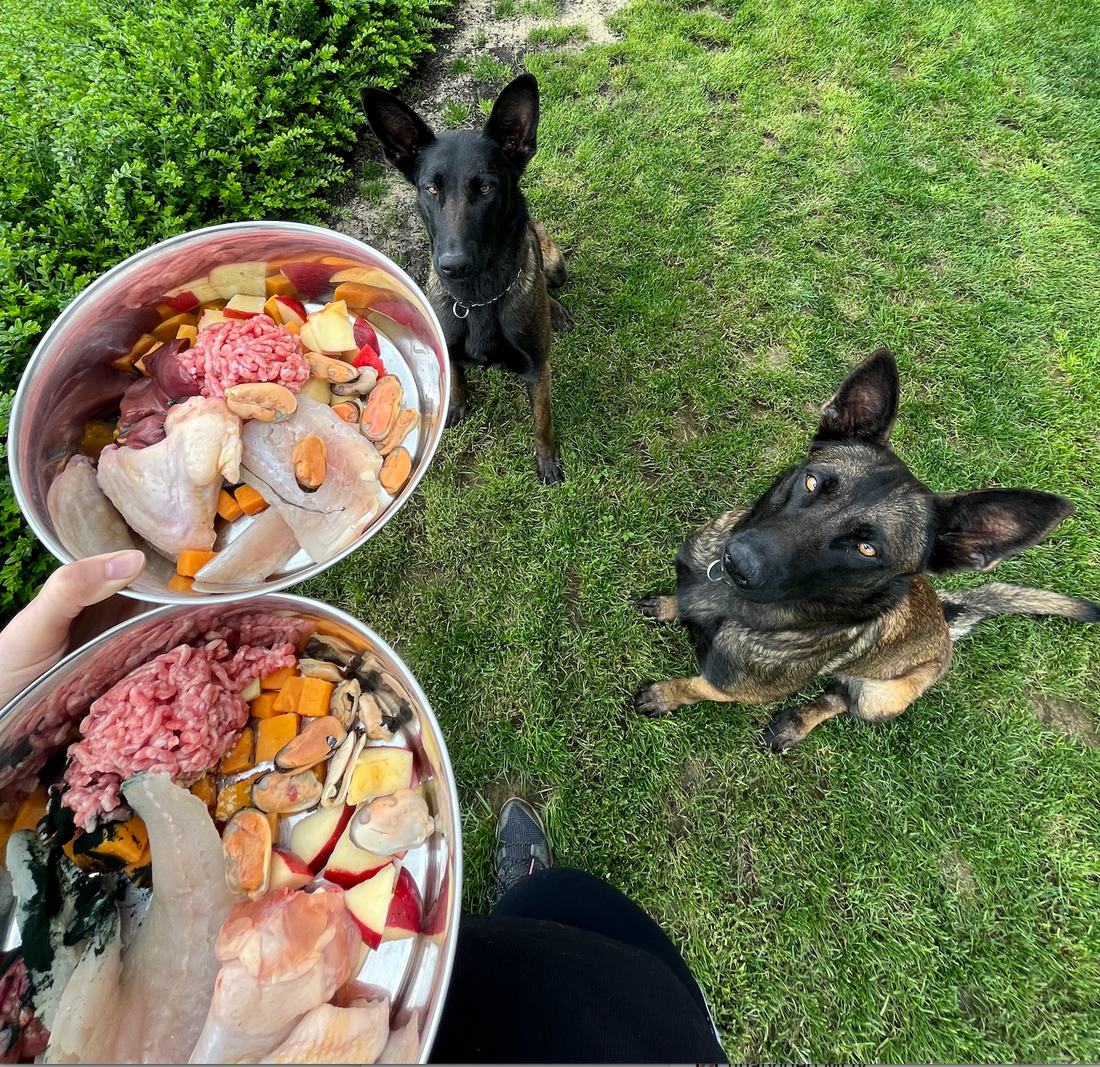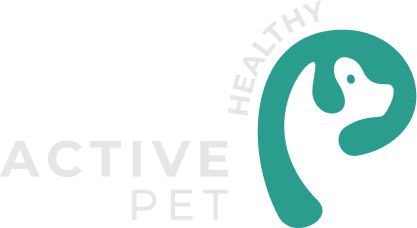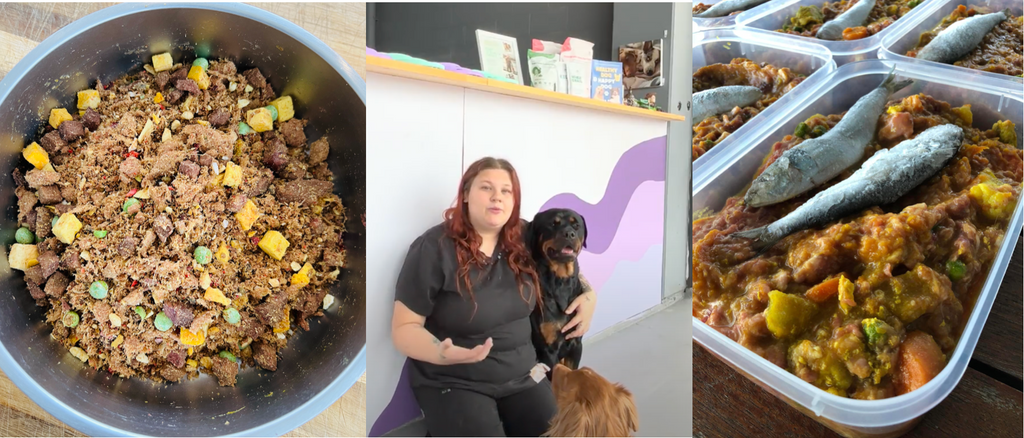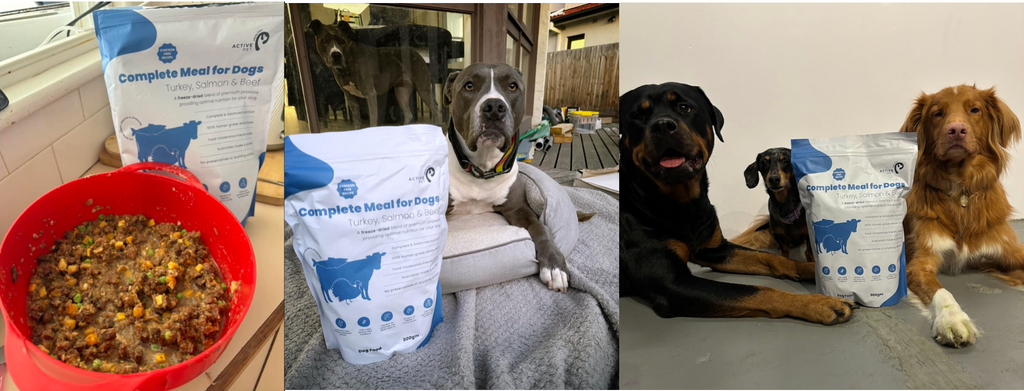
7 Common Raw Feeding Mistakes: Avoiding Raw Diet Pitfalls
Raw feeding has become increasingly popular among dog owners in recent years.
With a focus on providing a more natural and nutrient-dense diet, many are eager to make the switch to a raw food diet.
However, there are common mistakes that pet owners make when it comes to raw feeding, which can have adverse effects on their furry friend's health.

It's essential to understand these pitfalls to ensure that your pet's raw diet provides optimal nutrition and is safely prepared.
Here, we will highlight these mistakes to help you avoid common pitfalls and provide a well-balanced and healthy diet for your pets.
(P.S you can see our raw feeding dog recipe books here)
Key Takeaways:
- A balanced and diverse diet is essential to provide the necessary nutrients.
- Proper food handling practices, following food safety guidelines, and providing the appropriate portion sizes are essential for your pet's health.
- There may be a need for supplements to ensure a complete and balanced raw diet.
- It's important to transition your pet gradually and with care when introducing raw food to their diet.
Imbalanced Nutrition
When it comes to raw feeding, one of the most significant challenges is ensuring a balanced diet that meets all of your pet's nutritional requirements.
Providing a variety of protein, fat, and carbohydrates sources is not enough.
To achieve balance, we need to consider essential nutrients that should be included in your pet's raw food diet:
| Nutrient | Purpose | Food Sources |
|---|---|---|
| Protein | Builds and repairs tissues | Beef, chicken, lamb, turkey, fish |
| Fats | Source of energy, aids in nutrient absorption | Bone marrow, fish oil, egg yolks |
| Carbohydrates | Source of energy and fibre | Vegetables, fruits |
| Calcium | Supports bone health, muscle function, and nerve transmission | Ground eggshells, bone meal |
| Phosphorus | Involved in bone and cell function, energy metabolism, and acid-base balance | Meat, fish, bone meal |
| Vitamins and Minerals | Essential for various body functions, growth, and immune system support | Fruits, vegetables, organs |
| Water | Essential for proper body function, hydration, and digestion |
Ensuring all these nutrients are available in your pet's meals can be challenging.
Avoid over-supplementing your pet's diet, as this can cause imbalances. However, if you use home-prepared meals, ensure that the food is balanced - if you need some help see our wide selection of raw dog food recipes here
The nutritional benefit of the raw diet is enormous. By formulating a nutritionally balanced diet, you can offer your pet a healthier and more natural feeding approach.
(P.S you can see our raw feeding dog recipe books here)
Inadequate Calcium to Phosphorus Ratio
When it comes to raw feeding, maintaining the right balance of calcium and phosphorus is crucial for your pet's bone health. The recommended calcium to phosphorus ratio in a raw diet is 1:1 to 2:1.
Calcium is important for bone growth and strength, muscle and nerve function, and blood clotting. Phosphorus is necessary for forming bones and teeth, as well as helping the body metabolise carbohydrates and fats.
Feeding your pet an unbalanced diet with low calcium or high phosphorus can result in health issues, such as weakened bones, fractures, and dental problems.
You can ensure that your pet receives adequate calcium by adding raw meaty bones, such as chicken necks or beef ribs, to their diet. These bones not only provide a good source of calcium but also promote healthy teeth and gums.
Adding supplements such as bone meal or eggshells can also help meet your pet's calcium needs. You can also purchase calcium powder here
Including calcium-rich foods such as kale, broccoli, and salmon can also help balance your pet's calcium to phosphorus ratio.
| Food Type | Calcium (mg/100g) | Phosphorus (mg/100g) |
|---|---|---|
| Chicken Neck | 167 | 212 |
| Beef Ribs | 33 | 186 |
| Kale | 150 | 40 |
| Broccoli | 47 | 65 |
| Salmon | 12 | 220 |
By ensuring the proper calcium to phosphorus ratio in your pet's raw diet, you can help promote optimal bone health and overall wellbeing.
(P.S you can see our raw feeding dog recipe books here)
Lack of Variety in Protein Sources
At the core of raw feeding is variety, especially when it comes to protein sources. By offering a diverse range of proteins, our furry friends get all the necessary amino acids and other vital nutrients they need.
When it comes to protein choices, think beyond just chicken and beef. Consider other meats like lamb, turkey, and kangaroo. Variety can also come from non-meat sources such as eggs.
| Protein Source | Nutritional Benefits |
|---|---|
| Salmon | Rich in omega-3 fatty acids and high-quality protein |
| Bison | Low in fat with high amounts of iron and vitamin B12 |
| Kangaroo | Low in fat, high in protein and iron, and a good source of CLA (conjugated linoleic acid) |
| Organ meats (liver, heart, kidney) | A rich source of essential vitamins and minerals such as vitamin A, iron, and zinc |
Keep in mind that some dogs may have allergies or sensitivities to certain proteins, so it's crucial to gradually introduce new proteins and watch for any signs of intolerance.
Poor Food Handling Practices
When it comes to feeding your pet a raw diet, proper food handling practices are crucial to avoid bacterial contamination and foodborne illnesses that can be transmitted to pets, their owners, or both.
Here are some essential tips to ensure your raw feeding practices are hygienic:
- Wash your hands: Always wash your hands before and after handling raw food, including your pet's bowls and utensils. Use warm, soapy water for at least 20 seconds to reduce the risk of spreading bacteria.
- Use separate utensils: Raw meat should be handled separately from human food. Use dedicated utensils and cutting boards for your pet's food, and clean them thoroughly with hot, soapy water after use.
- Discard leftovers: Unused raw food should be discarded, including any uneaten portions after a meal. Do not refreeze previously thawed raw meat, as this can be a breeding ground for bacteria.
By following these tips, you can help reduce the risk of bacterial contamination and keep your pet and family safe while feeding them a raw diet.
Overfeeding or Underfeeding
Portion control is crucial when feeding your pet on a raw diet. Overfeeding can lead to weight gain and other health issues, while underfeeding can cause malnutrition and deficiencies. The amount of food your pet needs can vary depending on factors such as their age, breed, weight, and activity level.
The general guideline for portion control in raw feeding is to provide 2-3% of your pet's body weight in food per day, split into two meals.
However, it's essential to monitor your pet's weight regularly and adjust their portions accordingly.
| Factors influencing portion sizes: | Recommendations: |
|---|---|
| Age | Puppies require more food per pound of body weight than adult dogs. Senior dogs may require smaller portions due to decreased activity levels. |
| Breed | Some breeds, such as greyhounds, have faster metabolisms and may require larger portions. Smaller breeds may require smaller portions. |
| Weight | Overweight dogs should have smaller portions, while underweight dogs may require more food. Adjust portions as needed to maintain a healthy weight. |
| Activity level | Dogs with high activity levels, such as working or sporting dogs, may require larger portions. Less active dogs may need smaller servings. |
In addition to monitoring portions, it's essential to ensure that your pet receives all of the necessary nutrients from their raw diet.
Lack of Proper Supplements
Raw feeding offers numerous health benefits for your pets; however, it may not always provide all the necessary nutrients. That's where supplements come in. Supplements can help balance and complete your pet's raw diet, ensuring they receive all the essential nutrients they need to thrive.
Some of the essential supplements that should be included in your pet's raw diet are:
| Supplements | Description |
|---|---|
| Omega-3 Fatty Acids | Improves coat and skin, lubricates joints and reduces inflammation |
| Vitamin E | Protects against cell damage and boosts the immune system |
| Probiotics | Improves digestion and absorption of nutrients, boosts immune system |
| Calcium Supplements | Maintains healthy bones, teeth, and overall skeletal health |
It's essential to select supplements based on your pet's individual needs and health requirements. Always choose high-quality supplements and follow the manufacturer's instructions for dosage and administration carefully.
You can see our supplements in our shop here
Transitioning Properly to Raw
If you're considering transitioning your pet from kibble to a raw diet, it's crucial to do it gradually and with care. Moving too fast could result in an upset stomach, while a slow and steady transition will help your pet adjust to the new diet comfortably.
First, start by introducing a small amount of raw food, mixed in with your pet's usual kibble. Gradually increase the amount of raw food while decreasing the amount of kibble over the course of a week or two.
Monitor your pet's reaction to the new food carefully. If they experience any digestive issues or discomfort, slow down the transition process and try again in a few days.
It's also crucial to ensure your pet is getting all the necessary nutrients from the raw diet. Consult with your veterinarian for advice on how to create a balanced raw diet that meets your pet's specific needs.
Remember to always handle raw food safely to prevent contamination and reduce the risk of foodbourne illnesses. By taking things slow and steady, you can ensure a seamless transition to a healthy and nutritious raw diet for your furry friend.
(P.S you can see our raw feeding dog recipe books here)




